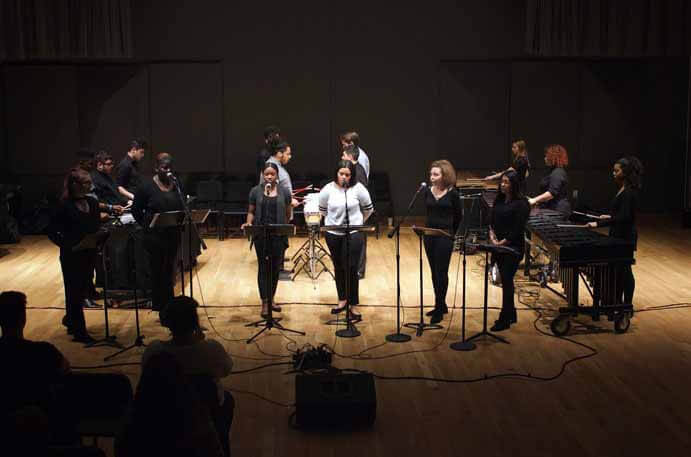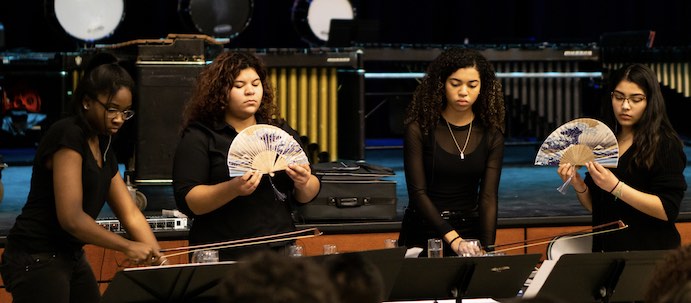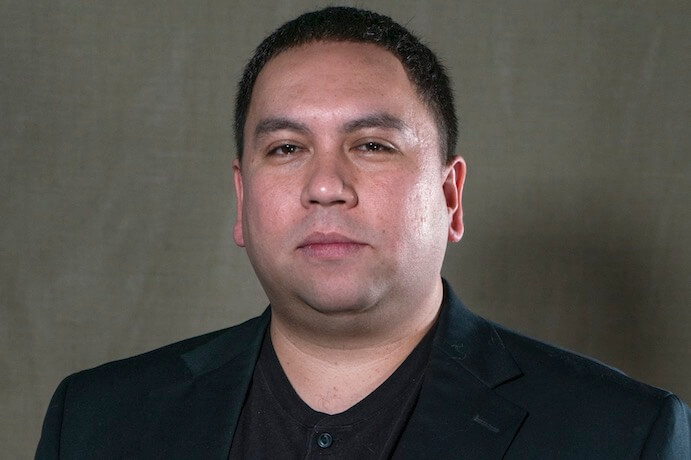Mantra Percussion hasn’t stopped moving since they were founded in 2009. Now heading into their tenth year as an ensemble, they are busy as ever, and are honing their artistic efforts through their Mantra Youth Percussion program. This year’s program features a quartet of four senior girls working exclusively on music written by composers of color including Angélica Negrón, Ayanna Woods, and Juri Seo. The quartet also has an impressive spring season coming up with 10 + concerts across New Jersey, Ohio, and New York.
We spoke with Mantra Percussion Co-Founder and Education Director Joe Bergen about Mantra Youth Percussion and how educators can empower students from underrepresented backgrounds.
Could you give a bit of background about Mantra Youth Percussion and how it was founded?
For Mantra Percussion, the idea of starting a youth percussion ensemble wasn’t necessarily due to a lack of offerings in the area–there are actually quite a few really elite level, audition-based groups sponsored by youth symphonies or pre-college conservatory programs. With Mantra Youth Percussion (MYP), our intentions for creating the group centered around offering a free program, open to students regardless of experience or means, where they can participate in professional-level concerts and work directly with composers, all under the guidance of a professional ensemble. Many other great new music groups have an educational wing tied to their organization, and they provide amazing opportunities in the form of workshops, masterclasses, composer readings, summer music festivals, and residencies, among other things. What was particularly important to us was having a program that ran week-to-week where we could develop students over a longer period. Since our inaugural year in 2014, MYP has performed over 50 concerts, with appearances at Carnegie Hall, Merkin Concert Hall, Roulette, National Sawdust, and New Music Gathering in Boston, and presenting over 30 works, half of them as MYP commissions with composers like Paula Matthusen, Angélica Negrón, Lainie Fefferman, Scott Wollschleger, and Brooks Frederickson writing for them.

Mantra Youth Percussion performed a precise and focused rendition of Reich’s “Drumming” at NMG2018 (photo by Austin Eamnarangkool)
How did Mantra Percussion get connected with Rahway High School?
Our first few years of existence happened without an actual home base and because of that, we found ourselves in a very tenuous circumstance where we had to rely primarily on rehearsing in people’s basements, oftentimes schlepping percussion gear for all 10-15 members. Around the same time, I started working as the head percussion teacher for the Rahway School District through my dear friend Miguel Bolivar, a brilliant educator and Peabody trained composer, who had just started his tenure as the high school band director there. For readers not familiar with the area, Rahway is a working class urban city in central New Jersey serving a predominantly black and hispanic student body. The high school enrollment is a little over 1,000 students with just under 50% eligible for free or reduced meals. The fine arts program has historically been a source of pride for the community, and Miguel and I were looking to build upon that. We saw an opportunity here to feature Mantra at the school by incorporating Mantra Youth Percussion into the already existing percussion program I oversaw. It proved to be a mutually beneficial partnership because of our shared teaching philosophies and our belief in offering high-level performance opportunities to our students.
How do you see the role of an educator evolving?
I see educators today taking a more careful look at the backgrounds of students lives as well as each student’s specific learning needs in order to give them a more specialized educational experience. It’s important for students to be able to connect with what they know from their own lives before you introduce them to information they don’t know. At Rahway, the younger grades focus first on popular music, classic band and orchestra rep, and beginning forms of improvisation and composition before introducing them to a broader range of musical styles and techniques. By the time they get to the repertoire we focus on in Mantra Youth Percussion, it’s seen as a natural extension of the music they’ve been listening to and playing their entire lives instead of a departure from it.

Mantra Youth Percussion–Photo by Jazmine Hazel Andes
What do you think is the biggest barrier to getting kids, especially kids from underrepresented and under-privileged backgrounds, access to new and classical music?
The biggest barrier, in my opinion, is believing that one exists simply because it hasn’t been addressed or removed yet. The students in Mantra Youth Percussion this year are four young women of color. They’re taught by myself and Mr. Bolivar, who are also POC. We all came together at the beginning of the season this year and collectively agreed that it was vital we focus on music by women composers of color. As a result of that conversation, our repertoire this year features Angelica Negron’s Count to Five, Juri Seo’s Four for Flexatones, a collaborative improvisation piece by the members, and Ayanna Woods Triple Point (with gracious permission from Third Coast Percussion). Having the members be a part of the conversation with the ability to voice their opinion on the narrative of our season as well as having the understanding that they’re involved in something profoundly important to the music community by featuring these amazing composers is in my mind exactly how to remove imaginary barriers.
There are tons of resources available for discovering new composers, especially women composers, composers of color, and trans composers, and yet there are folks within decision-making institutions who still don’t seem want to do the legwork in finding these voices. How can we tackle these barriers as educators and mentors?
I think as educators and mentors, we can sometimes easily fall into comfortable traps where year after year, we program the same types of music, attend the same competitions, festivals, and conferences, and share similar ideas with the same colleagues, adjudicators, and clinicians. This leads to concerts and festivals that may have great music involved, but that sadly feature a very homogeneous repertoire that doesn’t reflect the diverse society we live in or the communities we serve. To combat this, we can’t be afraid of paving our own path or taking risks, and we need to be ready to consistently articulate the importance of maintaining that vision to our colleagues and administrators on a daily basis. Change can happen, but only with a great amount of persistence from everyone involved.





















